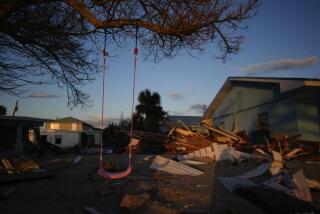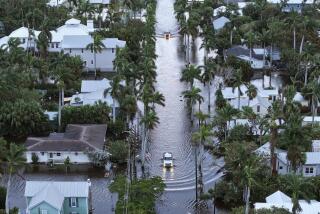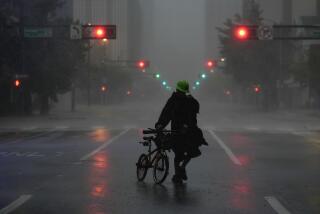Tornadoes Kill 40 in Rampage Across the South
ATLANTA — A huge chain of twilight tornadoes whirled and churned across the Deep South, leaving at least 40 dead, hundreds injured and thousands of homes damaged, ruined or simply vanished.
Despite hours of warning, many residents in Alabama, Georgia and Mississippi were caught defenseless Wednesday evening against the uncommonly punishing storms. Some victims were sucked from storm cellars and emergency shelters and whisked through the air. Their bodies were left dangling from trees, where neighbors found them in the eerie glare of early morning searchlights.
“This storm was so destructive that even [though] people did what they were supposed to do--going to their basements, taking the appropriate actions--we still had some fatalities,” said Paul Syx, spokesman for Alabama’s Jefferson County Emergency Management.
One Alabama woman was found alive inside her collapsed house about 14 hours after the first tornado touched down at dusk in Mississippi. But such miracles were few as rescue workers reported being hampered by debris-clogged roads and the worst power losses seen in years throughout the region.
They were also severely short-handed because rescue workers has been spread thin across the South by an unusually disastrous spring.
Only five weeks ago, rescue workers raced to southern Georgia and Alabama, where rivers had jumped their banks and left thousands homeless. Then, three weeks ago, many of the same workers had to be diverted to help residents of Gainesville, Ga., dig out from a tornado that killed 12.
Now, some of the same workers are trying to help the latest victims boil water, collect belongings and find make-do shelter.
In seven years in office, “there have been 14 disasters in Georgia that I’ve had to apply for federal assistance [for],” said Gov. Zell Miller. “The governor before me . . . in his eight years, he had two.”
Among the 11 killed in Georgia on Wednesday was a soldier training at Ft. Stewart, where several barracks were demolished, including one the size of a city block. The storms even intruded on the sedate world of professional golf, delaying the first round of the Masters Golf Tournament at Augusta National Golf Club, where workers took 90 minutes to clear the swamps of rainwater that fell overnight on the course.
Rawson Haverty Jr., vice president of Haverty Furniture in northwest Atlanta, opened his store Thursday morning to find a Chevron sign sitting inside among the leather recliners. The furniture store and the service station from which the sign blew away are on the same side of the street, roughly 200 yards apart.
“It must have gotten caught in a twirl,” he said of the sign, “because it literally had to go out over the highway and then back in the store.”
Particularly scary for Georgia and Alabama was how perilously close tornadoes came to both states’ major metropolitan areas. Birmingham was barely spared, though the tornadoes appeared headed straight for it, and in Atlanta, the city’s poshest northern suburbs looked like fresh battlefields Thursday morning, the smell of just-snapped pine and burst oak filling the rain-washed air, and nearly 1,000 homes heavily damaged or simply gone.
“Every house was taken down to the foundations,” said one Alabama rescue worker. “And a lot of them, even the foundations were taken.”
Though the storms did most of their damage just after dusk Wednesday, they continued to batter the South through the night and into Thursday, with tornado warnings issued in Virginia late in the day.
After monitoring TV footage of estate homes cut in two, telephone poles split like chopsticks and trucks pressed flat inside carports-turned-trash-compactors, President Clinton said, “It’s quite amazing.” He declared three counties disaster areas, with possibly more to come, and ordered Vice President Al Gore and Federal Emergency Management Agency head James Lee Witt to tour Alabama and Georgia today.
“I think you have 90 counties in Georgia that have an emergency right now,” Rep. Newt Gingrich (R-Ga.) told reporters after surveying his rain-soaked, ruin-strewn state. “It’s been an unusual spring in Atlanta and Georgia.”
But Wednesday night, right around sunset, nowhere was more unusual than Jefferson County, Ala., the hardest hit spot, as sirens wailed and officials warned residents to stay inside and go to their basements--often to no avail.
“A lot of people heard the warnings, a lot of people took action,” said Joe Schaefer, director of the Storm Prediction Center of the National Weather Service in Norman, Okla. “A few of them still died, and that’s saying we’ve got to do more work, figure out how to protect people.”
Though final data weren’t in yet, Schaefer said Wednesday’s storm, which spawned 20 to 50 tornadoes and mustered winds up to 250 mph, may be the most powerful recorded for some time to come. The last of equivalent size and magnitude was probably seen in Jarrell, Texas, last May, when more than 30 people died.
Alabama’s Gov. Forrest “Fob” James Jr. said at a morning news conference that along with the 24 confirmed dead in Alabama, more than 100 were injured, many critically. (Police put the number closer to 200, and the death toll in the state rose to 32 by nightfall.) He said the storm was the most vicious he’d seen as governor and that it promised to test the state’s emotional and financial resources.
At the Open Door Church, just west of Birmingham, a dozen people were injured after churchgoers sang hymns in the winds that howled around their sanctuary. The church was one of many across the Bible Belt where prayer groups turned instantly to prayer vigils.
“They call this Tornado Alley,” said Sgt. Mike Ozley of the Jefferson County Sheriff’s Department. “And we have a good many tornadoes touch down, hit a house or two and spring back up. But this was awesome. This tornado stayed on the ground for 2 1/2 miles, and it looks like a path of two-tenths of a mile wide. You’d think a hurricane would do this, not a tornado.
“It absolutely wiped clean everything in its path.”
Many Southerners blame El Nino for the strength and spate of storms this spring, along with the largest number of tornado deaths in 13 years--95. But Schaefer said forecasters are stumped by the current weather pattern and far from ready to blame El Nino.
“We can’t find any clue,” he said. “Whatever it’s related to is subtler than we are.”
Times researcher Edith Stanley contributed to this story.
More to Read
Sign up for Essential California
The most important California stories and recommendations in your inbox every morning.
You may occasionally receive promotional content from the Los Angeles Times.










